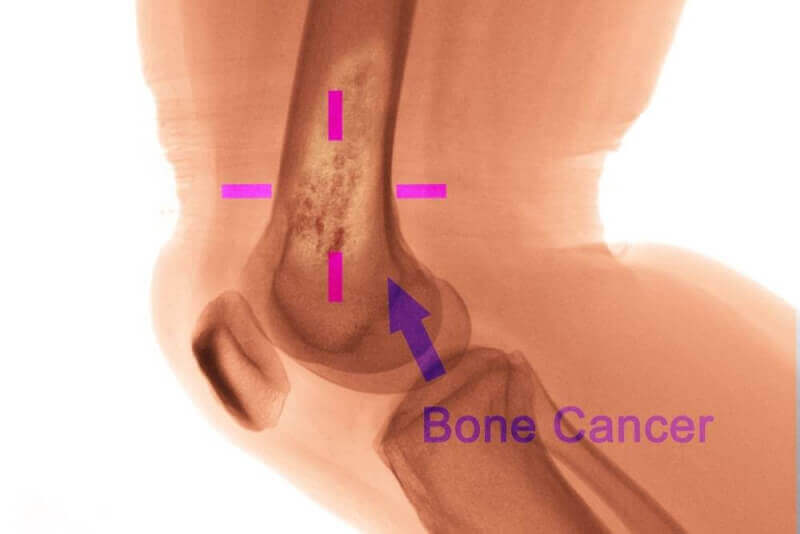Bone cancer, though rare but malignant, occurs in one out of every 100 cancer cases. Bone cancer can start in any bone in the body but is usually seen in the long bones of the arms and legs, as well as the pelvic bone. Bone cancers can metastasize to nearby organs and even distant ones. Some types of bone cancer affect children, while others affect adults.
What is Bone Cancer?
Bone cancers are malignant tumors that affect the skeletal system and damage the tissues there. Cancers that begin in the bone or the cartilage tissue in the joints and whose primary cancer site is these tissues are called bone cancer. The term "bone cancer" is not used for cancers that start in another organ and metastasize to the bone. The main treatment for bone cancer is surgical operations, which are especially successful when diagnosed early.
Symptoms of Bone Cancer
Since the symptoms of bone cancer are vague, it is usually diagnosed in later stages. The most characteristic symptoms of bone cancer are swelling and pain. However, both of these symptoms can be seen due to many other conditions, such as sports injuries or bone infections.
Pain is also among the symptoms of bone cancer seen in children. However, these pains are often thought to be related to growth. The main difference between cancer-related pain and growth pains is that growth pains are only experienced at night. On the other hand, bone cancer pain occurs continuously and becomes more severe over time.
Other common symptoms of bone cancer include:
- Unintentional weight loss,
- Fatigue,
- Lumps that become prominent on the bones,
- Bones breaking more easily than normal,
- Limited movement if the affected bone is near a joint,
- Bone pain that worsens over time and is especially worse at night,
End-Stage Symptoms of Bone Cancer
In cases where death occurs due to bone cancer, patients experience significant weakness and fatigue during their final weeks or months. While the exact time of death cannot be determined, the following symptoms are commonly seen in the last weeks of bone cancer patients:
- Increasing weakness and fatigue,
- Spending most of the day resting in bed,
- Loss of weight or muscle mass,
- Reduced or complete loss of appetite,
- Reduced speech,
- Decreased concentration,
- Loss of interest in the outside world,
- Disinterest in previously important matters,
- Not wanting to be around many people,
During the final days, symptoms may include:
- Slowed breathing,
- Long pauses between breaths,
- Wheezing,
- Bluish coloration of the hands and feet,
- Loss of bladder and bowel control,
- Reduced urine output,
- Restlessness,
- Repetitive and involuntary movements,
- Inability to recognize people, including family members,
- Confusion regarding time and place,
- Seeing people who are not there,
- Decreased response to touch or sound,
Stages of Bone Cancer
There is no staging for primary bone cancer of the spine and pelvis. Staging for bone cancer is available for bones of the body, skeleton, face, and skull.
Stage 1 Bone Cancer
In the first stage of bone cancer, low-grade tumors are present, and cancer cells are localized.
In the A phase of the first stage, the tumor is smaller than 8 cm, and there is no metastasis to the lymph nodes or other organs.
In the B phase of the first stage, there are multiple tumors in the same region, and their size is greater than 8 cm. However, the cancer cells have not spread to the lymph nodes or other organs.
Stage 2 Bone Cancer
In the second stage of bone cancer, cancer cells remain localized, but the tumor is of a higher grade.
In the A phase of the second stage, the tumor is high-grade but smaller than 8 cm, with no metastasis present.
In the B phase of the second stage, the tumor is high-grade and larger than 8 cm, but metastasis is still not present.
Stage 3 Bone Cancer
In the third stage of bone cancer, there are multiple high-grade tumors. However, cancer cells have not spread to the lymph nodes or other areas of the body. At this stage, cancer cells spread within the same bone.
Stage 4 Bone Cancer
In the final stage of bone cancer, the cancer has spread to other organs and bones, especially the lungs.
The fourth stage of bone cancer is divided into two phases. In the A phase, the tumor can be of any size or grade, and the cancer has metastasized to the lungs.
In the B phase of the fourth stage, the tumors may vary in size and grade, but the cancer has spread to the lymph nodes. Additionally, it has metastasized to other organs or bones.
Causes of Bone Cancer
The causes of bone cancer are generally unknown. However, certain risk factors increase the likelihood of developing bone cancer. These risk factors include:
- Babies born with an umbilical hernia are three times more likely to develop Ewing’s sarcoma during childhood.
- Individuals who have had retinoblastoma, a type of eye cancer during childhood, have a higher risk of developing bone cancer in adulthood. Both types of cancer are believed to have a genetic predisposition.
- People with Li-Fraumeni syndrome, which is caused by a mutation in a gene that suppresses the growth of cancer cells.
- Those with Paget’s disease, a disorder characterized by abnormal bone remodeling.
- Individuals who have previously undergone radiation therapy for other reasons.
Risk Factors for Bone Cancer
Bone cancer can affect people of any age or gender, but certain groups are at a higher risk of developing bone cancer.
Genetic Disorders and Family History
Some types of bone cancer are thought to be hereditary, particularly osteosarcomas. Additionally, individuals with Li-Fraumeni syndrome or retinoblastoma, a form of eye cancer, are at higher risk for bone cancer.
Previous Cancer Treatments
Exposure to radiation is one of the most important risk factors for bone cancer. The risk increases in individuals who received cancer treatment at a young age and were exposed to high doses of radiation. Childhood cancer survivors treated with chemotherapy also face an increased risk of bone cancer.
Paget’s Disease
Paget’s disease, which affects people over 50, causes abnormal bone tissue to form, leading to fragile or thickened bones. While Paget's disease itself is not cancer, in some cases, it can become cancerous.
Having Certain Types of Bone or Cartilage Tumors
Genetic conditions that cause bone tissue swelling or benign bone or cartilage tumors also increase the risk of bone cancer.
Bone Marrow Transplant
In some cases, patients who have undergone bone marrow transplants have developed osteosarcoma.
Types and Origin Sites of Bone Cancer
Bone cancers are classified based on the type of cell in which they begin. The most common types of bone cancer include:
Osteosarcoma
Osteosarcoma is the most common type of bone cancer and starts in the cells that form bone tissue. It usually begins in the long bones of the arms and legs but can occur in any bone. It most commonly affects children and young adults.
Ewing Sarcoma
Ewing’s sarcoma consists of several different tumors but originates from similar cells. It can begin in the soft tissue surrounding the bone. Common sites include the pelvis, shoulder blades, and long bones in the legs.
Chondrosarcoma
Chondrosarcoma begins in cartilage tissue. It can occur when parts of the cartilage transform into bone tissue due to calcium deficiency. Common areas include the pelvis, arm, and leg bones. It typically affects older adults.
Chordoma
Chordoma begins in the bones of the spine, usually at the base of the spine or skull. It occurs more frequently in older adults and is more common in men.
How Is Bone Cancer Diagnosed?
The first method used to diagnose bone cancer is an X-ray, as these images can easily differentiate between the tumor and bone tissue.
However, it is important to determine the location and type of the tumor to plan treatment. Techniques such as scintigraphy, computed tomography (CT), and magnetic resonance imaging (MRI) are used for this purpose. These imaging techniques help to examine the tumor’s relationship with surrounding tissues, its spread, and blood supply.
The purpose of CT scans is to view bone details, while MRI is used to see the spread of the tumor, soft tissue involvement, or the extent of the tumor inside the bone.
To determine if there is metastasis, bone scintigraphy is performed. In cases of bone pain, particularly in children, X-rays are the first method used.
After applying these techniques, a biopsy is necessary for a definitive diagnosis.
Bone Cancer Treatment Methods
Several factors are considered when determining the treatment for bone cancer, including the stage of the cancer, its type, location, aggressiveness, and whether it has metastasized.
Benign Bone Tumors
Benign bone tumors in children can sometimes disappear on their own. Therefore, regular monitoring and close observation are sufficient.
Surgery is required for benign bone tumors if they cause fractures, hinder bone growth, if there is diagnostic uncertainty, or if they cause bone deformity.
The goal of surgery for benign bone tumors is to remove the tumor tissue and fill the empty space with either the patient’s bone tissue or donor tissue from a bone bank.
Surgical Treatment
The goal of surgical treatment is to remove the cancerous tissue and the surrounding tissue. It is the most common treatment for bone cancer. To achieve complete success, the surgeon must remove all cancerous tissue. Leaving even a small part of the cancerous tissue may lead to cancer progression and spread. In such cases, additional radiation therapy may be required.
Limb-sparing surgery involves removing only the damaged tissue without amputating the entire limb. However, patients may experience functional loss in the affected limb after surgery. To address this, reconstructive surgery is performed, using either a bone graft from another part of the patient’s body or an artificial bone replacement.
In some cases, it is not possible to remove all cancerous tissue through limb-sparing surgery, and amputation may be necessary. However, advances in surgical techniques have reduced the need for such procedures.
Surgery Summary
Duration of Surgery: 2-5 hours
Type of Anesthesia: General
Hospital Stay: 5-14 days
Return to Work: 2-6 months
Fibula Method
This method is commonly used in children. In cases of bone cancer in children, the growth plate and joint surface, along with the bone, are removed. However, the fibula, along with the growth plate, is transplanted to the patient, allowing normal bone growth to continue without complications.
Another group that benefits from using the fibula are patients whose tumor has spread throughout the femur. In these cases, the empty space in the femur can be filled with the fibula. If the body does not reject the bone after a one-year waiting period, patients regain their health.
Lastly, the fibula can be used instead of bone cement in treatments where frozen bone is used. In this method, the frozen bone, which is preserved at -180 degrees with nitrogen, is embedded in the fibula-filled bone.
Radiotherapy
As with many cancer treatments, high-energy X-rays are used in the treatment of bone cancer. Radiotherapy is applied after surgery or to patients who do not require surgery. While it is the standard treatment for Ewing's sarcoma, it is used in combination with other methods for other types of bone cancer.
Chemotherapy
Chemotherapy uses powerful drugs to kill bone cancer cells. It is usually used to treat Ewing’s sarcoma and osteosarcoma. When combined with radiotherapy, it yields more effective results.
Immunotherapy
Immunotherapy targets the molecules responsible for cancer cell growth and is generally used to treat patients with osteosarcoma. It is applied in addition to other treatment methods.
Symptoms of Bone Cancer Metastasis
The symptoms of bone cancer metastasis vary depending on which organ is affected. The most common organs where bone cancer metastasizes include the breast, prostate, lungs, thyroid, and kidneys.
Lung Metastasis
When bone cancer spreads to the lungs, the symptoms are often vague because they resemble symptoms of other health conditions. Symptoms of lung metastasis from bone cancer include:
- Coughing
- Coughing up blood
- Chest pain
- Shortness of breath
Kidney Metastasis
When bone cancer metastasizes to the kidneys, symptoms may include:
- Loss of appetite
- Blood in the urine
- Anemia
- Persistent flank pain
- High fever
- Fatigue and weakness
- Swelling in the legs and joints
- Abdominal swelling
Breast Metastasis
If bone cancer metastasizes to the breast, symptoms may include:
- Lump in the breast
- Breast pain
- Redness of the breast skin
- Breast tenderness
- Nipple discharge
- Peeling of the breast skin
- Changes in breast shape and size
- Swelling under the armpit
- Inverted nipple
Prostate Metastasis
Symptoms of prostate metastasis include:
- Unintentional weight loss
- Pain during ejaculation
- Difficulty urinating
- Blood in the urine or semen
- Frequent urination
- Erectile dysfunction
Thyroid Metastasis
Lastly, the thyroid is one of the most common organs where bone cancer metastasizes. Symptoms of thyroid metastasis include:
- Lump in the neck
- Hoarseness
- Difficulty swallowing
- Bone fractures
- Toxic goiter










